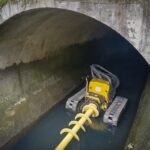Inspection and maintenance duties are essential in many industrial sectors, such as damaged infrastructure, tunnels, refineries, and old buildings. Companies spend billions of dollars every year on inspections and maintenance.
Mobile Robots
Mobile robots enable the automation of processes such as inspecting and maintaining situations that pose a risk to workers. There are hazardous or difficult-to-access situations for people, such as nuclear power plants, the chemical industry, where poisonous compounds are handled, or sites where there is a risk of collapse, among others. Mobile robotics can assure operator safety and penetrate difficult-to-reach areas. They can also assist to reduce the cost of operations and mistakes caused by weariness or bad environmental conditions. This has led to an increase in the demand for AMR (Autonomous Mobile Robots) both for end users and for R&D projects in recent years.
Robotic Crawlers
Robotic Crawlers provide a simple and rapid restricted space inspection option as part of a routine maintenance and monitoring operation. These robots use a distinctive track design to get access to locations that are just unattainable with existing technology. Crawlers are useful for routine or emergency inspections at petrochemical plants, nuclear power plants, hydroelectric facilities, refineries, and other facilities. This durable inspection robot’s adaptability provides an all-in-one solution for small and medium-sized pipes, tanks, boreholes, or other restricted locations where a downhole camera is required. Anyone who has to undertake remote visual inspections in restricted locations with limited access should consider adding these robots to their NDT toolset. There are several setup choices available to discover how this works.
Climbing Robots
Climbers are portable, remote-controlled machines that can ascend practically any vertical or inverted surface. Because they are handled securely from the ground, people are not exposed to perilous heights or toxic environments. Climbing robots must be built based on the intended duties and application sector. These factors determine whether locomotion principles or adhesion systems are appropriate, as well as the size of the robot. Such devices can scale walls, tanks, ships, building structures, dams, and towers, among other things. There are several configurations available according to their work and application.
Underwater Robots
Underwater robots help with inspections, repairs, and upkeep. These autonomous robotic vehicles eliminate the requirement for manually controlled surface boats. They feature a narrow, flexible shape that allows them to traverse great distances and do light inspection, maintenance, and repair tasks underwater in limited locations. The robots which are outfitted with a variety of important sensors and equipment may be put on both current and new fields. They can be used for visual examination, cleaning, and operating valves and chokes, among other things. This system allows for significant savings in subsea inspection and intervention expenditures, as well as time spent on inspections, repairs, and maintenance.
Inspection and maintenance robots can find applications in industries such as Petrochemical, Oil & Gas, Nuclear, Mining, and in Municipal and Underwater applications. We have solutions for all the mentioned applications and more, to access more information on these solutions please write to us at open-innovator@quotients.com






